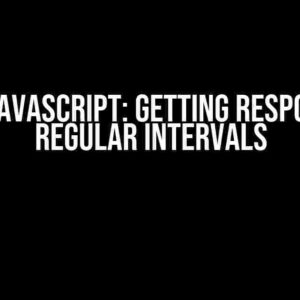When working with third-party REST services in Java, one of the most common questions developers ask is: “Who provides the POJO (Plain Old Java Object) classes?” In this article, we’ll dive into the world of RESTful APIs, explore the role of POJO classes, and provide clear instructions on how to consume third-party REST services in Java.
What are POJO Classes?
Before we dive into the main topic, let’s quickly cover what POJO classes are. POJO stands for Plain Old Java Object, and it refers to a simple Java class that represents a data structure or an object. POJO classes are used to hold and transport data between different layers of an application or between different applications. In the context of RESTful APIs, POJO classes are used to represent the data exchanged between the client and the server.
Why Do We Need POJO Classes?
So, why do we need POJO classes when consuming third-party REST services in Java? The answer is simple: POJO classes provide a way to map the data received from the REST service to a Java object that can be easily used in our application. Without POJO classes, we would have to parse the JSON or XML data manually, which can be error-prone and time-consuming.
Who Provides the POJO Classes?
Now, let’s get back to the main question: who provides the POJO classes? There are three possible scenarios:
- The Third-Party Service Provider: In some cases, the third-party service provider may provide Java client libraries that include the necessary POJO classes. These libraries often include a set of Java classes that match the data structures used by the REST service.
- Automated Tools: There are automated tools available that can generate POJO classes from the REST service’s API documentation or from sample data. Some popular tools include Swagger Codegen, JSON2POJO, and WireMock.
- Manual Implementation: In some cases, you may need to create the POJO classes manually. This involves writing Java classes that match the data structures used by the REST service.
Consuming Third-Party REST Services in Java
Now that we’ve covered the role of POJO classes, let’s dive into the process of consuming third-party REST services in Java.
Step 1: Obtain the API Documentation
The first step in consuming a third-party REST service is to obtain the API documentation. This can be in the form of a PDF document, an online API portal, or even a sample API call. The API documentation should provide information on the available endpoints, request and response formats, and any authentication requirements.
Step 2: Choose a HTTP Client Library
The next step is to choose an HTTP client library that can be used to make requests to the REST service. Some popular HTTP client libraries for Java include:
- OkHttp
- Apache HttpClient
- Unirest
- Jersey Client
Step 3: Create the POJO Classes
Once you have chosen an HTTP client library, you need to create the POJO classes that will be used to represent the data exchanged with the REST service. You can use one of the three approaches mentioned earlier: using a third-party service provider’s client library, using automated tools, or creating the classes manually.
For example, let’s say we’re consuming a REST service that provides weather information. We can create a POJO class called `WeatherData` that represents the data returned by the service:
public class WeatherData {
private String temperature;
private String humidity;
private String windSpeed;
// getters and setters
}Step 4: Make the API Call
With the POJO classes in place, we can now make the API call using the chosen HTTP client library. Here’s an example using OkHttp:
OkHttpClient client = new OkHttpClient();
Request request = new Request.Builder()
.url("https://api.weather.com/data")
.build();
Response response = client.newCall(request).execute();
if (response.isSuccessful()) {
WeatherData weatherData = gson.fromJson(response.body().string(), WeatherData.class);
System.out.println("Temperature: " + weatherData.getTemperature());
} else {
System.out.println("Error: " + response.code());
}Step 5: Handle Errors and Exceptions
The final step is to handle errors and exceptions that may occur when making the API call. This can include catching and handling exceptions, checking for error codes, and logging errors for debugging purposes.
Best Practices for Consuming Third-Party REST Services in Java
When consuming third-party REST services in Java, it’s essential to follow best practices to ensure reliable and efficient communication. Here are some tips:
- Use a robust HTTP client library: Choose an HTTP client library that is well-maintained, has a good reputation, and provides features such as connection pooling and caching.
- Use a JSON/XML parser: Use a JSON/XML parser such as Jackson or JAXB to parse the data received from the REST service.
- Implement error handling: Implement robust error handling to handle exceptions and errors that may occur when making the API call.
- Use caching: Implement caching to reduce the number of API calls and improve performance.
- Monitor API usage: Monitor API usage to detect and prevent abuse.
Conclusion
In this article, we’ve covered the role of POJO classes in consuming third-party REST services in Java, explored the three approaches to obtaining POJO classes, and provided clear instructions on how to consume third-party REST services in Java. By following best practices and using the right tools and techniques, you can ensure reliable and efficient communication with third-party REST services.
| Tool/Library | Description |
|---|---|
| Swagger Codegen | Automatically generates client code for RESTful APIs |
| JSON2POJO | Generates POJO classes from JSON data |
| WireMock | Simulates RESTful APIs for testing and development |
Remember, when consuming third-party REST services in Java, it’s essential to choose the right approach for obtaining POJO classes, follow best practices, and use the right tools and techniques to ensure reliable and efficient communication.
I hope this article has been informative and helpful!
Frequently Asked Question
Get the lowdown on consuming third-party REST services in Java, and who provides those POJO classes we all love to use!
Who is responsible for providing POJO classes for third-party REST services?
Typically, the third-party service provider doesn’t supply the POJO (Plain Old Java Object) classes. Instead, as a consumer of their REST service, you’ll need to create these classes yourself, or use a tool like JAXB (Java Architecture for XML Binding) to generate them from the service’s XML schema definition. Alternatively, you can also use online tools or libraries like json2java or swagger-codegen to generate the POJO classes for you!
What if the third-party service doesn’t provide an XML schema definition?
No worries! If the service provider doesn’t offer an XML schema definition, you can still create the POJO classes manually, or use tools like json2java, which can generate classes from JSON sample data. You can also use swagger-codegen, which supports generating code from OpenAPI definitions (formerly known as Swagger definitions). These tools can help you get started with consuming the REST service, even without an XML schema definition.
Can I use libraries like Jackson or Gson to convert JSON to Java objects?
Absolutely! Libraries like Jackson or Gson can be used to convert JSON data from the third-party REST service into Java objects. These libraries provide a way to deserialize JSON data into your custom POJO classes, making it easy to work with the data in your Java application. Just create your POJO classes, and these libraries will take care of the JSON-to-Java object conversion for you!
Do I need to create POJO classes for every single endpoint of the third-party REST service?
Not necessarily! While it’s a good idea to have a POJO class for each endpoint’s response, you can also use generic or wrapper classes to handle responses that share a common structure. For example, if multiple endpoints return a list of items, you can create a single POJO class to handle those responses. However, if the endpoints return vastly different data structures, it’s best to create separate POJO classes for each endpoint.
Are there any best practices for creating POJO classes for third-party REST services?
Yes, there are! When creating POJO classes, it’s essential to follow JavaBeans conventions, use meaningful variable names, and keep your classes simple and lightweight. Additionally, consider using immutable classes, and avoid using complex logic or business rules within your POJO classes. By following these best practices, you’ll ensure that your POJO classes are easy to understand, maintain, and extend, making your life as a Java developer much easier!



